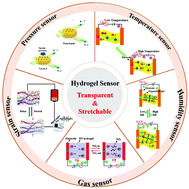Transparent stretchable hydrogel sensors: materials, design and applications
Abstract
Flexible sensors have great potential for human motion sensing, medical monitoring, electronic skin and display devices. Flexible hydrogel sensors with transparent characteristics have a good visual effect, which can be used for “invisible” devices and visual optical monitoring, as well as to improve the aesthetics of devices for daily usage, etc. However, there are no systematic reviews on the working principle, characteristics and application prospects of transparent stretchable hydrogel sensors. In this review, we summarize recent advances in wearable strain sensors, pressure sensors, temperature sensors, humidity sensors and gas sensors based on transparent stretchable hydrogels, emphasizing materials, designs and applications. We also discuss the combinations and applications of sensors with emerging technologies such as wearable devices, artificial intelligence, human–computer interaction and 3D printing. Finally, this review presents a brief summary, challenges, and perspectives of transparent stretchable hydrogel sensors.

- This article is part of the themed collections: 2023 Journal of Materials Chemistry C Lunar New Year collection, 2022 Journal of Materials Chemistry C Most Popular Articles and Journal of Materials Chemistry C Emerging Investigators


 Please wait while we load your content...
Please wait while we load your content...